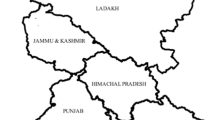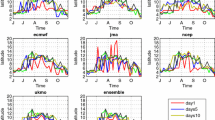Abstract
The real-time multi-model ensemble (MME)-based extended range (up to 3 weeks) forecast of monsoon rainfall over India during the 2012 monsoon season is analyzed using the outputs of European Centre for Medium Range Weather Forecasts (ECMWF) monthly forecast coupled model, National Centre for Environmental Prediction (NCEP) Climate Forecast System version 2 coupled model and Japan Meteorological Agency (JMA)’ ensemble prediction system. Although the individual models show useful skill in predicting the extended range forecast of monsoon, the MME forecast is found to be superior compared to these. For the country as a whole, the correlation coefficient (CC) between the observed and MME forecast rainfall departure is found to be statistically significant (99 % level) at least for 2 weeks (up to 18 days). Over the four homogeneous regions of India, the CC is found to be significant (above 95 % level) up to 2 weeks except in case of northeast India, which shows significant CC for week 1 (days 5–11) only. On the meteorological subdivision level (India is divided into 36 meteorological subdivisions) the mean percentage of correct forecast is found to be much higher than the climatology forecast. Considering the complex problem of forecasting of monsoon in the extended range timescales, the MME-based predictions for 2–3 weeks provide skillful results and useful guidance for application in agriculture and other sectors in India.











Similar content being viewed by others
References
Bhatla R, Mohanty UC, Raju PVS, Madan OP (2004) A study on dynamic and thermodynamic aspects of breaks in the summer monsoon over India. Int J Climatol 24(3):341–360
Brankovic C, Palmer TN (1997) Atmospheric seasonal predictability and estimates of ensemble size. Mon Wea Rev 125:859–874
Buizza R, Palmer TN (1995) The singular vector structure of the atmospheric global circulation. J Atmos Sci 52:1434–1456
Casanova S, Bodo A (2009) On the weighting of multimodel ensembles in seasonal and short-range weather forecasting. Mon Wea Rev 137:3811–3822
Chen TC, Yen MC (1994) Interannual variation of the Indian monsoon simulated by the NCAR Community Climate Model: effect of the tropical Pacific SST. J Clim 7:1403–1415
De US, Chatterjee SN, Sinha Roy KC (1988) Low frequency mode in summer monsoon circulation over India. Mausam 39:167–178
Gadgil S, Asha G (1992) Intraseasonal variation of the summer monsoon. I: observational aspects. J Meteor Soc Japan 70:517–527
Gadgil S, Rao PRS (2000) Famine strategies for a variable climate—a challenge. Curr Sci 78:1203–1215
Hoyos CD, Webster PJ (2007) The role of intra-seasonal variability in the nature of Asian monsoon precipitation. J Clim 20:4402–4424
Khole M, Yadav BP, Devi SS (2013) Onset, advances and withdrawal of southwest monsoon. In Pai DS, Bhan SC (ed), Monsoon 2012—A Report. IMD Met. Monograph. Synoptic Meteorology No. 13/2013, pp 1–14
Klingaman NP, Woolnough SJ, Weller H, Slingo JM (2011) The impact of finer-resolution air-sea coupling on the intraseasonal oscillation of the indian monsoon. J Clim 24:2451–2468
Krishnamurti TN, Subrahmanyam D (1982) The 30–50-day mode at 850 mb during MONEX. J Atmos Sci 39:2088–2095
Krishnamurti TN, Kishtawal CM, LaRow TE, Bachiochi DR, Zhang Z, Williford CE, Gadgil S, Surendran S (1999) Improved weather and seasonal climate forecasts from multimodel superensemble. Science 285:1548–1550
Krishnamurti TN, Kishtawal CM, Zhang Z, LaRow T, Bachiochi D, Williford E, Gadgil S, Surendran S (2000) Multimodel ensemble forecasts for weather and seasonal climate. J Clim 13:4196–4216
Krishnamurti TN, Mitra AK, Yun WT, Vijay Kumar TSV (2006) Seasonal climate forecasts of the Asian monsoon using multiple coupled models. Tellus 58A:487–507
Krishnan R, Zhang C, Sugi M (2000) Dynamics of breaks in the Indian summer monsoons. J Atmos Sci 57:1354–1372
Krishnan R, Sundaram S, Swapna P, Kumar Kumar, Ayantika DC, Mujumdar M (2010) Crucial role of ocean–atmosphere coupling on the Indian monsoon anomalous response during dipole events. Clim Dyn 37:1–17
Lawrence DM, Webster PJ (2002) The boreal summer intraseasonal oscillation: relationship between northward and eastward movement of convection. J Atmos Sci 59:1593–1606
Madden R, Julian P (1971) Detection of a 40–50 day oscillation in the zonal wind in the tropical Pacific. J Atmos Sci 28:702–708
Madden R, Julian P (1972) Description of global-scale circulation cells in the tropics with a 40–50 day period. J Atmos Sci 29:1109–1123
Madden R, Julian P (1994) Observations of the 40–50 day tropical oscillation: a review. Mon Wea Rev 112:814–837
Pai DS, Bhate J, Sreejith OP, Hatwar OP (2011) Impact of MJO on the intraseasonal variation of summer monsoon rainfall over India. Clim Dyn 36:41–55
Palmer TN, Coauthors (2004) Development of a European multimodel ensemble for seasonal-to-interannual prediction (DEMETER). Bull Am Meteor Soc 85:853–872
Palmer TN, Brankowic C, Viterbo P, Miller MJ (1992) Modelling interannual variations of summer monsoons. J Clim 5:399–417
Pattanaik DR (2003) The northward moving low frequency mode: a case study of 2001 monsoon season. Mausam 54:937–940
Pattanaik DR, Arun Kumar (2010) Prediction of summer monsoon rainfall over India using the NCEP climate forecast system. Clim Dyn 34:557–572
Pattanaik DR, Tyagi A, Kumar A (2012a) Dynamical-empirical forecast for the Indian monsoon rainfall using the NCEP Coupled modelling system—application for real time monsoon forecast. Mausam 63:433–448
Pattanaik DR, Mukhopadhyay B, Kumar A (2012b) Monthly forecast of Indian southwest monsoon rainfall based on NCEP’s coupled forecast system. Atmos Clim Sci 2: 479–491. doi:10.4236/acs.2012.24042
Raju PVS, Bhatla R, Mohanty UC (2009) The evolution of mean conditions of surface meteorological fields during active/break phases of the Indian summer monsoon. Theor Appl Climatol 95(1):135–149
Ramamurthy K (1969) Monsoon of India: some aspects of ‘break’ in the Indian South west monsoon during July and August, in Forecasting Manual, Part IV.18.3, India Meteorological Department, New Delhi
Robert P, Crispian PB, Robert JPH, Karl ET, Peter JG (2008) Evaluating the present-day simulation of clouds, precipitation, and radiation in climate models. J Geophys Res 113:D14209. doi:10.1029/2007JD009334
Saha S, Nadiga S, Thiaw C, Wang J, Wang W, Zhang Q, Van den Dool HM, Pan HL, Moorthi S, Behringer D, Stokes D, Pena M, Lord S, White G, Ebisuzki W, Peng P, Xie P (2006) The NCEP climate forecast system. J Clim 19:3483–3517
Saha S, Moorthi S, Wu X, Wang J, Nadiga S, Tripp P, Pan H-L, Behringer D, Hou Y-T, Chuang H-y, Iredell M, Michael Ek, Meng J, Yang R, van den Dool H, Zhang Q, Wang W, Chen M (2013) The NCEP Climate Forecast System Version 2. J Clim (under review)
Samala BK, Krishnan R, Roxy M (2012) Assessment of one month forecasts of weak Indian monsoons based on the NCEP Climate Forecast System (CFS). Meteorol Appl 19:189–199
Shukla J, Anderson J, Baumhefner D, Brankovic C, Chang Y, Kalnay L, Marx L, Palmer TN, Paolino DA, Ploshay J, Schubert S, Straus DM, Suarez M, Tribbia J (2000) Dynamical seasonal prediction. Bull Am Meteor Soc 81:2593–2606
Sikka DR, Gadgil S (1980) On the maximum cloud zone and the ITCZ over Indian longitudes during the southwest monsoon. Mon Wea Rev 108:1840–1853
Singh SV, Kripalani RH, Sikka DR (1992) Interannual variability of the Madden–Julian oscillations in Indian summer monsoon rainfall. J Clim 5:973–978
Soman MK, Slingo J (1997) Sensitivity of Asian summer monsoon to aspects of sea surface temperature anomalies in the tropical Pacific Ocean. Quart J Roy Meteor Soc 123:309–336
Sperber KR, Palmer TN (1996) Interannual tropical rainfall variability in general circulation model simulations associated with the Atmospheric Model Intercomparison Project. J Clim 9:2727–2750
Terray L, Sevault E, Guilyardi E, Thual O (1995) The OASIS coupler user guide version 2.0. CERFACS Tech. Rep. TR/CMGC/95-46, 123 pp
Tyagi Ajit, Pattanaik DR (2010) Real time monitoring and forecasting of intra-seasonal monsoon rainfall activity over India during 2009. IMD Met. Monograph. Synoptic Meteorology No. 10/2010
Tyagi A, Pattanaik DR (2012) Real time extended range forecast activities in IMD—Performance Assessments and Future Prospects. IMD Met. Monograph No. ERF 01/2012, pp 1–132
Vitart F (2004) Monthly forecasting at ECMWF. Mon Wea Rev 132:2761–2779
Vitart F, Buizza R, Balmaseda MA, Balsamo G, Bidlot J-R, Bonet A, Fuentes M, Hofstadler A, Moleni F, Palmer TN (2008) The new VAREPS-monthly forecasting system: a first step towards seamless prediction. Q J R Meteorol Soc 134:1789–1799
Wang B, Kang IS, Lee JY (2004) Ensemble simulations of Asian–Australian monsoon variability by 11 AGCMs. J Clim 17(4):803–818
Wang B, Lee JY, Kang IS, Shukla J, Park CK, Kumar A, Schemn J, Cocke S, Kug JS, Luo JJ, Zhou T, Wang B, Fu X, Yun WT, Alves O, Jin EK, Kinter J, Kirtman B, Krishnamurti TN, Lau NC, Lau W, Liu P, Pegion P, Rosati T, Schubert S, Stern W, Suarez M, Yamagata T (2008) Advance and prospects of seasonal prediction : assessment of the APCC/CliPAS 14-model ensemble retrospective seasonal prediction (1980–2004)
Wang W, Chen M, Kumar A (2009) Impacts of ocean surface on the northward propagation of the boreal summer intraseasonal oscillation in the NCEP climate forecast system. J Clim 22:6561–6576
Webster PJ, Hoyos CD (2004) Prediction of monsoon rainfall and river discharge on 15–30 day time scales. Bull Am Met Soc 85:1745–1765
Wheeler M, Hendon H (2004) An All-Season Real-Time Multivariate MJO Index: development of an Index for Monitoring and Prediction. Mon Wea Rev 132:1917–1932
Wu MLC, Schubert S, Kang IS, Waliser D (2002) Forced and free intraseasonal variability over the south Asian monsoon region simulated by 10 AGCMs. J Clim 15(20):2862–2880
Yasunari T (1979) Cloudiness fluctuations associated with the northern hemisphere summer monsoon. J Meteor Soc Japan 57:227–242
Yeh D, Tao S, Li M (1959) The abrupt change of circulation over Northern Hemisphere during June and October. In: The atmosphere and sea in motion, Rockefeller Institute Press, Oxford, pp 249–267
Yu WD, Shi JW, Liu L et al (2012) The onset of the monsoon over the Bay of Bengal: the observed common features for 2008–2011. Atmos Ocean Sci Lett 5(4):314–318
Zhang C (2005) Madden-Julian Oscillation. Rev Geophys 43:1–36
Acknowledgments
We sincerely acknowledge the ECMWF, NCEP, JMA for providing the real-time forecast products of their coupled models, which have been used for preparing the multi-model ensemble forecast of Indian monsoon rainfall. The author is thankful to the Director General, India Meteorological Department (IMD) and Deputy Director General of Meteorology, NWP division, IMD for providing all facility to carry out this work. Thanks are also due to NASA GSFC for providing TRMM rainfall data and the Hydrology Unit of IMD for making available the daily met-Subdivisional level rainfall data used in the present study. Thanks are due to the anonymous reviewers for their valuable comments, which were helpful to improve the quality of the paper.
Author information
Authors and Affiliations
Corresponding author
Additional information
Responsible editor: B. Ahrens.
Rights and permissions
About this article
Cite this article
Pattanaik, D.R. Meteorological subdivisional-level extended range forecast over India during southwest monsoon 2012. Meteorol Atmos Phys 124, 167–182 (2014). https://doi.org/10.1007/s00703-014-0308-6
Received:
Accepted:
Published:
Issue Date:
DOI: https://doi.org/10.1007/s00703-014-0308-6




